| In
the beginning there was a river, The river became a road and branched
out to the whole world. And because the road was once a river it was
always hungry.
Ben
Okri
Provided
by Us
 Perhaps
the most important thing: 15 years experience running professional
river expeditions in Nepal and world-wide. In the last eight years
of operation in Nepal we have run every commercial first descent of
rivers in Nepal. We run high water trips on all Nepal's wild rivers
and this experience shows in all we do. Perhaps
the most important thing: 15 years experience running professional
river expeditions in Nepal and world-wide. In the last eight years
of operation in Nepal we have run every commercial first descent of
rivers in Nepal. We run high water trips on all Nepal's wild rivers
and this experience shows in all we do.
- Expedition elements include professional guides
and leadership, private ground transportation, porters and permits.
- Tasty and carefully prepared western meals,
rum punch, tea, coffee and snacks. We always offer a vegetarian
option and can cater to special diets.
- State-of-the-art Equipment: self bailing rafts,
lifejackets, helmets, wetsuits on certain rivers, dry bags for gear,
tents, and camera barrels.
Not included
are bottled/alcoholic beverages, any kind of insurance, visa costs,
and expenses of a personal nature.
What
to Bring
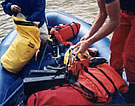 Personal
Equipment: The less luggage you have to carry around the more you
will enjoy yourself. Clothing should ideally be light weight, dry
quickly, and provide insulation even when wet. Synthetic fibres are
preferable to cotton on the river for this reason. Here is a fairly
extensive to serve as a guide… Personal
Equipment: The less luggage you have to carry around the more you
will enjoy yourself. Clothing should ideally be light weight, dry
quickly, and provide insulation even when wet. Synthetic fibres are
preferable to cotton on the river for this reason. Here is a fairly
extensive to serve as a guide…
For
Camping and Travelling
- A sleeping bag and pad. Your sleeping bag should
be a two to three season bag, either down or synthetic filled. A
foam pad or Thermarest sleeping mattress is mandatory for a good
nights sleep. For those who do not have a sleeping bag and pad,
they can be rented easily in Kathmandu or Pokhara for about fifty
cents a day.
- Lightweight pants.
- Cotton underwear.
- Light weight long sleeved shirt or T-shirt.
We use these as sunscreen in camp....don't worry about getting enough
sun, you will.
- A fleece style jacket. Polypropylene or wool
is preferable.
- Toiletries: keep it to a minimum, and forget
the cosmetics...., you won't have a chance to use them. Bring plenty
of moisturising lotion.
- Spare glasses or contact lenses if you wear
them.
- Flashlight or headlamp with spare batteries.
- Water-bottle
River
Wear
-
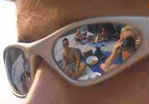 River
sandals like Teas or Alps are the preferred footwear on the river.
It is essential that all rafters have footwear that they can wear
in the raft which will not come off in the event of a swim , as
this is considered standard safety equipment. Old running shoes
will also do. River
sandals like Teas or Alps are the preferred footwear on the river.
It is essential that all rafters have footwear that they can wear
in the raft which will not come off in the event of a swim , as
this is considered standard safety equipment. Old running shoes
will also do.
- Shorts or a swimming costume.
- A sarong for women (a long piece of cloth wrapped
around your waist) is another good option, and can be purchased
cheaply in Nepal. This is invaluable for visiting villages and respecting
local custom for dress.
- A baseball style cap and good sunglasses are
absolutely essential. Sunglasses should be equipped with a retaining
device to keep them on your face where they belong.
- Sunscreen (spf 15 or or greater and waterproof)
is essential DON'T FORGET LIP BALM, SPF 15 MINIMUM!
For
Trekking (Karnali, Marsyangdi and Tamur Expeditions)
- A day pack for the trek to the river.
- Long sleeved thermal top and bottoms (long
underwear).
- Light and medium weight weaves are the handiest.
- Walking shoes or light weight hiking boots
are a must. People who are used to walking long distances over uneven
terrain will do fine with light hiking shoes or even running shoes.
Some of the guides will do the trip in Teas, but if you saw their
feet, you'd opt for better footwear. Heavy mountaineering boots
are more of a burden than a blessing.
- Toilet paper and a lighter- nice to have a
spare.
Optional
Items
- Small binoculars for wildlife viewing in the
national parks.
- Camera and film. Also bring a good cleaning
kit, as field conditions are harsher than in towns. Spare batteries
are also handy.
- Fishing equipment.
- Walk/Discman and tunes.
- Reading and writing material.
- Personal first aid kit.
Perhaps the
most important thing you can bring is a good mental attitude...
Personal
Spending
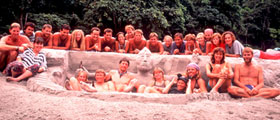 There
is not a lot you can buy on a river in Nepal, bearing that in mind
you will not need to take much in the way of money, say 500-1000 rupees
(US$15). We'll fill you in on the beer kitty when you get here. Chocolate,
sweets and cigarettes are seldom available anywhere on the rivers;
so bring a few treats for yourself, they can be great bargaining chips
for that massage you may need on the layover day... There
is not a lot you can buy on a river in Nepal, bearing that in mind
you will not need to take much in the way of money, say 500-1000 rupees
(US$15). We'll fill you in on the beer kitty when you get here. Chocolate,
sweets and cigarettes are seldom available anywhere on the rivers;
so bring a few treats for yourself, they can be great bargaining chips
for that massage you may need on the layover day...
A
Day on the River
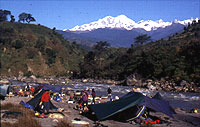 There
are no rules to running rivers other than those dictated by common
sense. To enjoy and learn, the participants need to be flexible and
adaptive in changing situations. With this in mind here's what we
normally plan on any river journey... There
are no rules to running rivers other than those dictated by common
sense. To enjoy and learn, the participants need to be flexible and
adaptive in changing situations. With this in mind here's what we
normally plan on any river journey...
We rise at dawn with the sun and wander to the
campfire where a huge pot of coffee is waiting. After a hearty breakfast
and loading the rafts, we start rafting. We try to get on the water
by around 9am. On the river you'll paddle hard through the rapids
and cruise in between. On any of the larger volume rivers you could
safely say about 30 percent of the time is spent running rapids and
70 percent cruising.
The day's rafting is punctuated with a leisurely
lunch break around midday, as well as stops to scout the more challenging
rapids, explore temples and villages, waterfalls and other interesting
sights. The length of time spent rafting is directly related to our
choice of spectacular campsites. Typically we are on the water 4-6
hours each day.
We get into camp around 3-4pm in the afternoon
and there is plenty of time to explore and relax. On longer trips
there is always a layover day built into the itinerary, a chance to
do as little or as much as you wish. These areas are also difficult
to get to... it would be a shame to end up rushing.
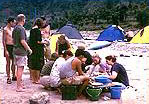 Evenings
are spent around the campfire, drinking hot spiced rum and getting
to know the people on the trip. Food is communally prepared, every
day a different raft crew helps with the simple preparation of vegetables.
The kitchen becomes one of the main social points on the trip, and
without a doubt the best place to catch up on the latest gossip or
get to know someone better..."Gut that chicken for you, mam?" Evenings
are spent around the campfire, drinking hot spiced rum and getting
to know the people on the trip. Food is communally prepared, every
day a different raft crew helps with the simple preparation of vegetables.
The kitchen becomes one of the main social points on the trip, and
without a doubt the best place to catch up on the latest gossip or
get to know someone better..."Gut that chicken for you, mam?"
After a few days on the river, time has little
meaning, river times takes over. Having played hard all day, it's
often a surprise to look at your watch before going to bed to find
it's only 8pm, whereas you were sure it was closer to 10. The next
day we begin all over.
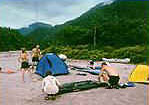 Longer
expeditions have the advantages of offering some real heart thumping
whitewater with the incredible journeying aspect of a long river trip.
With more time on the river, things are more relaxed, relationship
progress at a more natural pace, and memories become firmly entrenched
for a lifetime. Long after the whitewater has blurred into one long
white-knuckled thrilled ride, the memories of a moonrise over the
river and the friends you inevitably make will remain. Longer
expeditions have the advantages of offering some real heart thumping
whitewater with the incredible journeying aspect of a long river trip.
With more time on the river, things are more relaxed, relationship
progress at a more natural pace, and memories become firmly entrenched
for a lifetime. Long after the whitewater has blurred into one long
white-knuckled thrilled ride, the memories of a moonrise over the
river and the friends you inevitably make will remain.
Nepal, for all it's massive mountain peaks and
impressive geography, is actually an incredibly fragile environment.
At Ultimate Descents our lives have revolved around the free flowing
river. We feel an increased responsibility to protect and preserve
these wild places. Not only do we leave every campsite cleaner than
when we've arrived, we've taken steps to protect Nepal's rivers and
the people who live along them.
If you would like membership information on the
Nepal River Conservation Trust (NRCT) or like to join our yearly trip
in September to support eco-conscious tourism along Nepal's rivers,
simply contact us here.
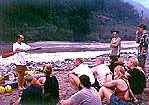 At
Ultimate Descents, we take safety very seriously. It is our first
and never forgotten priority, and it shows. We employ some of the
best rafting guides in the world. These men and women are whitewater
professionals, trained in CPR, emergency wilderness first aid and
swift-water rescue. Safety kayakers accompany each expedition and
can get a person out of trouble faster than anyone else. At
Ultimate Descents, we take safety very seriously. It is our first
and never forgotten priority, and it shows. We employ some of the
best rafting guides in the world. These men and women are whitewater
professionals, trained in CPR, emergency wilderness first aid and
swift-water rescue. Safety kayakers accompany each expedition and
can get a person out of trouble faster than anyone else.
Equipment is another element of of being prepared
for anything. Rafting, like flying, scuba diving or safe sex, is intrinsically
dependent on using the most advanced and reliable equipment. We use
the best rafts, flotation devices, helmets and paddles available.
You can help us by doing your part as well. Listen
to your guides and take safety seriously. |






 |
|






 Evenings
are spent around the campfire, drinking hot spiced rum and getting
to know the people on the trip. Food is communally prepared, every
day a different raft crew helps with the simple preparation of vegetables.
The kitchen becomes one of the main social points on the trip, and
without a doubt the best place to catch up on the latest gossip or
get to know someone better..."Gut that chicken for you, mam?"
Evenings
are spent around the campfire, drinking hot spiced rum and getting
to know the people on the trip. Food is communally prepared, every
day a different raft crew helps with the simple preparation of vegetables.
The kitchen becomes one of the main social points on the trip, and
without a doubt the best place to catch up on the latest gossip or
get to know someone better..."Gut that chicken for you, mam?" Longer
expeditions have the advantages of offering some real heart thumping
whitewater with the incredible journeying aspect of a long river trip.
With more time on the river, things are more relaxed, relationship
progress at a more natural pace, and memories become firmly entrenched
for a lifetime. Long after the whitewater has blurred into one long
white-knuckled thrilled ride, the memories of a moonrise over the
river and the friends you inevitably make will remain.
Longer
expeditions have the advantages of offering some real heart thumping
whitewater with the incredible journeying aspect of a long river trip.
With more time on the river, things are more relaxed, relationship
progress at a more natural pace, and memories become firmly entrenched
for a lifetime. Long after the whitewater has blurred into one long
white-knuckled thrilled ride, the memories of a moonrise over the
river and the friends you inevitably make will remain.